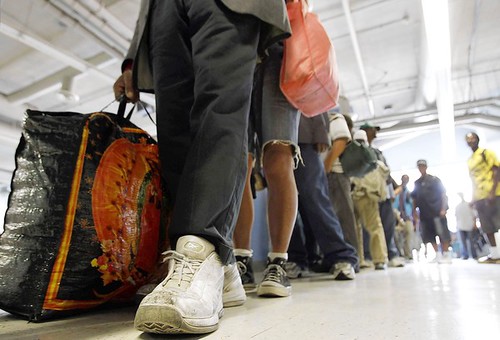
Men line up for free lunches at the Union Rescue Mission in downtown Los Angeles on Tuesday, Sept. 13, 2011. New census data shows the national poverty rate has increased to levels not seen since 1993., a photo by Pan-African News Wire File Photos on Flickr.
Poverty rates up in most U.S. states, cities: Census
5:07pm EDT
By Lisa Lambert
WASHINGTON (Reuters) - The ranks of the poor rose in almost all U.S. states and cities in 2010, despite the end of the longest and deepest economic downturn since the Great Depression the year before, U.S. Census data released on Thursday showed.
Mississippi and New Mexico had the highest poverty rates, with more than one out of every five people in each state living in poverty. Mississippi's poverty rate led, at 22.4 percent, followed by New Mexico at 20.4 percent.
New Hampshire had the lowest poverty rate, at 8.3 percent, making it the only state with a poverty rate below 10 percent.
Twelve states had poverty rates above 17 percent, up from five in 2009, while poverty rates in 10 metropolitan areas topped 18 percent, the data showed.
"We saw the recession hit and unemployment increase, but we haven't seen a dramatic drop in unemployment," said Elizabeth Kneebone, a senior research associate focusing on metropolitan issues at the Brookings Institution.
"Because we're still in this weak recovery, we could see these numbers get worse before they get better," she added.
The U.S. recession that began in 2007 took a steep toll across the country, sparing only a few places from rising joblessness and crashing incomes. More than a year after the recession officially ended in 2009, the U.S. unemployment rate remains above 9 percent; the poverty rate rose to 15.3 percent in 2010 from 14.3 percent in 2009.
"No state had a statistically significant decline in either the number of people in poverty or the poverty rate between 2009 and 2010." the Census reported.
Kneebone, of the Brookings Institution, noted that many of the big increases in the poverty rate in the first year of the recession were centered in the inner-mountain west and the Sunbelt.
"As the recession deepened and spread to other industries, other regions of the country also saw their numbers increase," she said, noting that areas reliant on manufacturing had not fully recovered from a downturn earlier in the decade when the recession struck.
The depth of poverty levels increased in 2010, with 6.8 percent of people having incomes that were no more than half of the federal government's official poverty threshold. That was up from 6.3 percent in 2009.
Poverty ran deepest in Washington, D.C., where one in 10 people had incomes less than 50 percent the threshold.
The Census also looked at the 366 metropolitan areas that account for more than 80 percent of the U.S. population.
The Texas region defined by the cities of McAllen, Edinburg and Mission had the highest poverty rate in the country -- 33.4 percent. It was followed the Fresno, California, area at 26.8 percent.
Poverty rates topped 18 percent in metropolitan areas centered around El Paso, Texas; the cities of Bakersfield, Modesto and Stockton in California; Augusta, Georgia; Memphis, Tennessee; and both Durham and Greensboro in North Carolina as economic problems spread from core urban areas to the suburbs over the decade.
"Many communities are facing this challenge in a magnitude they've never had to deal with before," said Kneebone, who said there are now 2.7 million more people in suburbs than cities.
Despite the deep poverty levels in the District of Columbia, the nation's capital, the Washington, D.C., metropolitan area had the lowest poverty rate in the nation, at 8.4 percent, due to its wealthier suburbs. Honolulu had the second lowest, 9.1 percent.
The numbers of people collecting food stamps and relying on Medicaid, the government healthcare program for the poor, skyrocketed in recent years. The Census also found that in 2010 more people collected other forms of public assistance than in 2009.
In 2010, 3.3 million people received public assistance at some time in the year, an increase of 300,000 from 2009. Among U.S. households, about 2.9 percent received public assistance in 2010, up from 2.7 percent in 2009.
The states with the highest public assistance participation included Alaska, Maine, Vermont and Washington. The states with the lowest rates were Louisiana, Alabama and Wyoming.
Although Alaska and Maryland had poverty rates of 9.9 percent in 2010, the margins of error for those states were greater than 0.3 percent.
(Editing by Leslie Adler)
No comments:
Post a Comment